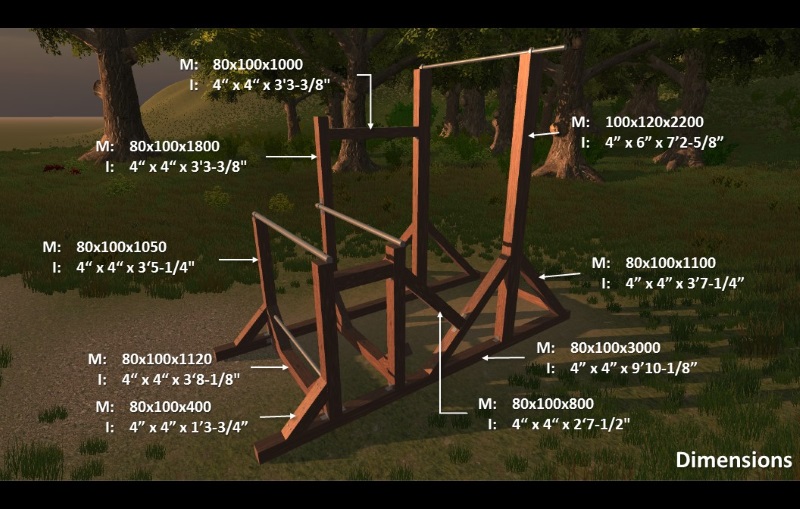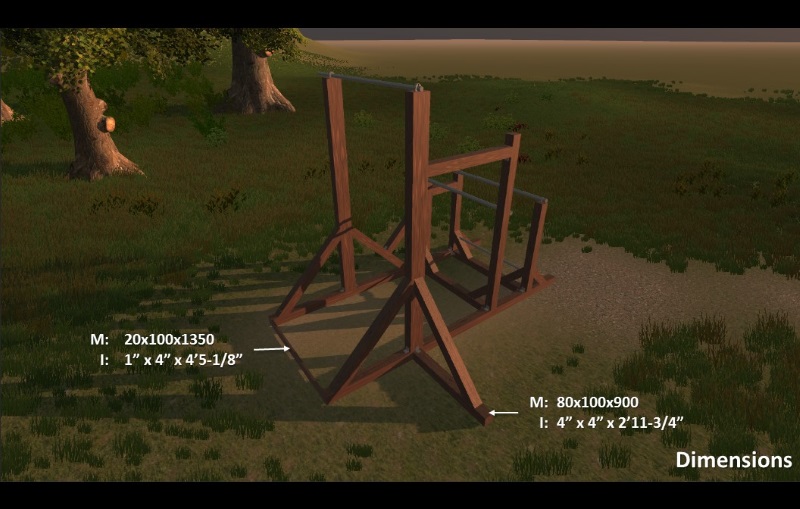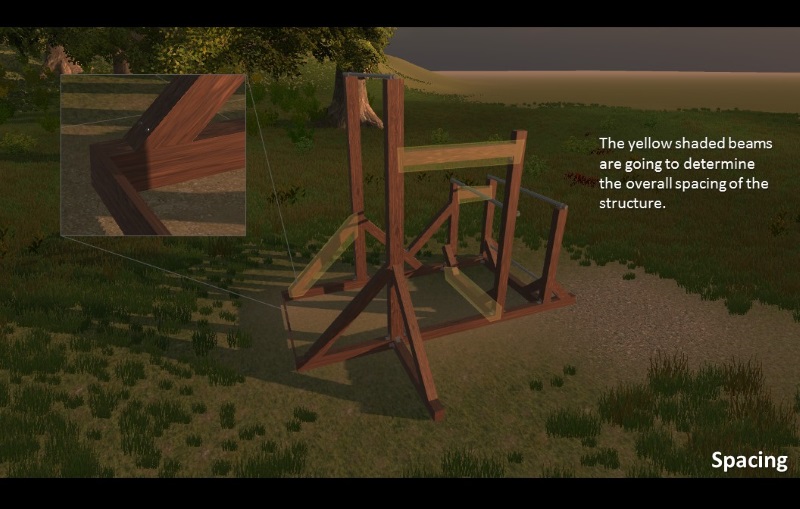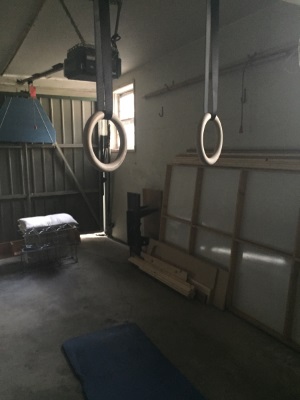
After I had decided to start this exercise adventure but before rings came into the picture, there was a brief time where building some sort of structure in the back yard was under consideration. I ended up getting some rings – they’re so versatile, and I’ll have… wow… YEARS of work exploring what can be done with them – but that notion of designing and building still appeals to me.
In class the other day students were working diligently on their prototypes and in that little lull I decided to reach back to my architecture roots and model something for construction in my current game engine of choice, Unity. Past and present collide! The object of my efforts: the exercise structure described here by Calisthenic Movement’s Alex (El Eggs).
In the video above, a commenter asked about getting the structure’s dimensions in Imperial units. I did some conversions and pretty quickly realized that the 80x100cm beams didn’t map well to typical Imperial lumber dimensions. Deciding that 4” x 4” would work (which is really 3-1/2” x 3-1/2”), I set out to see just how different a metric build would be from an Imperial build. The answer: Not Much. There are differences, but they’re slight. The screenshots below are both from the Imperial build.
The Imperial dimensions shown were rounded up to the nearest 1/8” in most cases. I think there’s a missing beam in the materials list in the video. It’s either the one that is set perpendicular to the base to anchor the brace for the high bar upright beam OR the brace for the inner parallel bar upright beam. When I positioned the 80x100x900 beam to brace the parallel bar upright beam it seemed long, so I decided that the 80x100x900 beam was part of the base (shown above) and added a slightly shorter beam to the list, 80x100x800 (4” x 4” x 2’7-1/2”), to brace the parallel bar upright beam.
What I Learned
ONE I found the process of building this and manipulating it in 3D enlightening. It helped me to understand the video and the structure a lot better. Fitting the pieces together was a logic puzzle. For example: Alex calls out the 100cm beam specifically, so the placement of that beam was certain. The placement of others had to be matched up with how many there were and what role they played. It wasn’t a super challenging puzzle, but it was fun to piece it all together.
I have a much better grasp on what I would want out of a structure like this should I ever design one. And I have a good start on a mock up for it. 🙂 I feel confident that I could design one to my own specifications.
Overall, this structure is pretty straightforward and versatile; the most complex areas are the bar for working on the human flag and the offset interior brace (shown below).
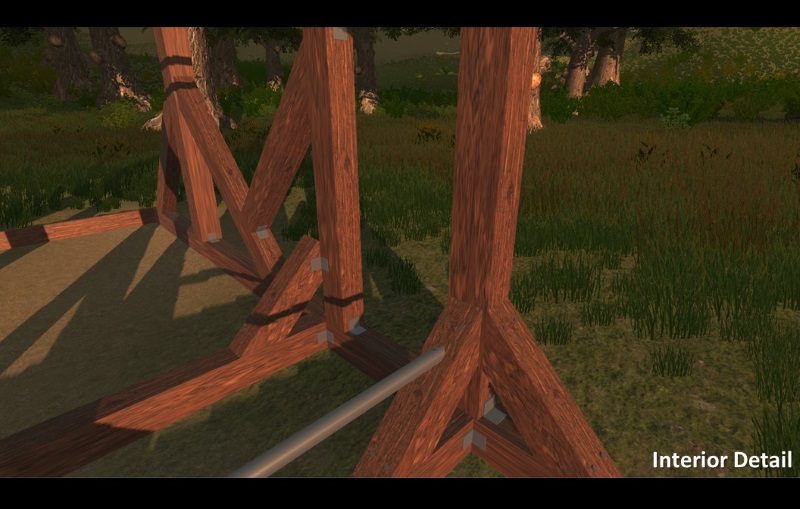
TWO The overall structure described has some critical dimensions related to customizing it to your needs:
- Your personal dimensions:
- Height of the parallel bar uprights: 80x100x1050 (4” x 4” 3’5-1/4”)
- Height of the high bar uprights: 100x120x2200 (4” x 6” x 7’2-5/8”)
- Width of the spacer between the parallel bar uprights: 80x100x400 (4” x 4” x 1’3-3/4”)
- Your space:
- Length of the base beams: 80x100x3000 (4” x 4” x 9’10-1/8”)
- Width of the base beams: 80x100x1120 (4” x 4” x 3’8-1/8”)
- Extra width of the perpendicular base beam: 80x100x900 (4” x 4” x 2’11-3/4”)
THREE Unity out of the box is not great for precise architectural work. Particularly with Imperial units. These, once converted from metric to find the appropriate lumber size, were REconverted to metric to make entering the sizes into Unity easier. This wasn’t that much easier, particularly, because some of the X, Y and Z positions ended up being to the thousandths in Unity units. It was incredibly fiddly and – ultimately – I ended up eyeballing some of the abutments.
I have a ‘playable’ version of this available. If you want to take a look around this for yourself, drop me a line at the contact page and be sure to specify if you use Mac or Windows.
List of Boards/Planks (metric and Imperial)
- 80x100x3000 (2) – base
- 4″x4″x9’10-1/8″
- 80x100x1100 (4) – braces
- 4″x4″x3’7-1/4″
- 80x100x1050 (3) – parallel bar uprights
- 4″x4″x3’5-1/4″
- 80x100x1800 (1) – parallel bar upright
- 4″x4″x5’11”
- 80x100x400 (7) – braces
- 4″x4″x1’3-3/4″
- 80x100x1000 (1) – brace/bar
- 4″x4″x3’3-3/8″
- 80x100x1120 (2) – base
- 4″x4″x3’8-1/8″
- 100x120x2200 (2) – high bar uprights
- 4″x4″x7’2-5/8″
- 80x100x900 (1) – base
- 4″x4″x2’11-3/4″
- 20x100x1350 (1- base end cap
- 1″x4″x 4’5-1/8″
- 80x100x800 (1) – brace (added)
- 4″x4″x2’7-1/2″
